|
Song
Dog Kennels
|
|
|
|
Home
of SONG DOG KENNELS -- Copyrighted Registry for the AMERICAN
INDIAN DOGS
|
BREEDING BACKWARDS & HOW IT IS DONE
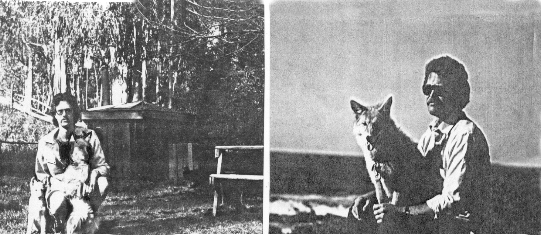
KIM
WITH DUSTY
KIM & SANDANCER
ROADS & HER PUP
AT THE BEACH
DAWNING MOON
EARLY 1980'S
Understanding selective breeding
and Breeding backwards
This next article “ Return of a Legend” is an excellent example of how you can, through selective breeding, bring back something thought to be extinct. All you need is, to know what they where before, to find individuals related close enough, to selectively breed the unwanted genes out & keep the desired characteristics in. I call this breeding backwards. Of coarse it helps when you have a very survivable breed you’re working with.
This brings up another very important point also. You can’t breed to fast forward, without the help from evolution or selective breeding. For an example, there are wolf & or coyote hybrid breeders trying to market their hybrids as Indian Dogs. To justify this, some claim to have found a dog on a reservation, or got one from a Native American. I might also add, just because it’s from a reservation or belonged to a Native American, does not make it an Indian Dog. Native Americans can have any breed from Poodles to Hounds. They say if you take this dog & cross it with a wolf or coyote wala ’ you have an Indian Dog – WRONG!
The Native Americans respected & revered wolfs & coyotes, but they selectively bred Dogs, originally bred from wolfs & coyotes, 1000’s of years ago, like all breeds of dogs, but they didn’t have hybrids. They did not have wolfs & coyotes as working members of their family groups, it would not be very practical.
The American Indian Dogs where & are a loyal, working, trainable Dog that looks like its wild cousins. This cross would be like taking a bay Donkey & crossing it with a Zebra & calling it a Guagga, just because it looked alike. It must look like it, act like it, sound like it, feels like it, smell like it & have the same DNA, to be IT!
Please, read the next very nice article, it may help SOME to understand why & what I have done with the selecting & breeding of the A.I.Dogs.
Thanks, Kim La Flamme
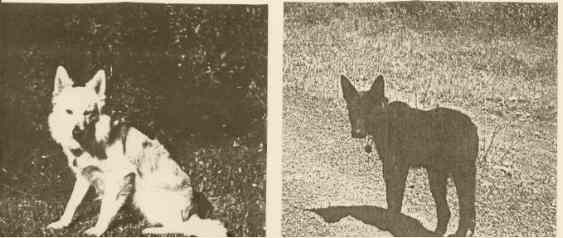
THESE
ARE EXAMPLES OF THE SLIGHT
DIFFERENCES OF DOG'S OF DIFFERENT REGIONS.
LEFT
IS COMBINATION OF PLAINS AND HARE
INDIAN DOGS.
RIGHT
IS OF SOUTHEASTERN
AND SOUTHWESTERN TYPES COMBINED. THESE
ARE ALSO DOGS IN THE FOUNDATION BREEDING.
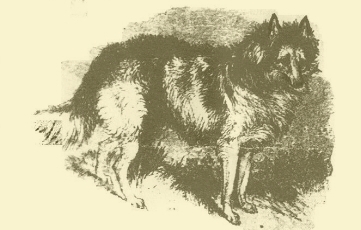
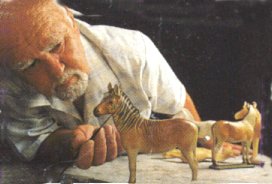
of what he has brought
back from EXTINCTION
RETURN
OF A LEGEND
New Life
For A Vanished Zebra?
By Don
Boroughs
At The foot of Table Mountain, where tall grasses bake brown in the South African summer sun, Reinhold Rau dumps a box full of fresh green lawn clippings onto the ground & backs away. A trio of unusually colored zebras approaches cautiously for a nibble, while another stallion trots straight for the white-bearded visitor. “ Paul, you naughty bugger,” he shouts, rushing into the cab of his pickup & cranking up the window. “ He just wants to be cuddled,” explains Rau, “but he doesn’t know his own strength.”
The zebra has good reason to feel such affection for his nervous friend. Five years before, Rau had found young Paul, only a few hours old, wandering aimlessly among the herd. Nearby, his mother lay dead, presumably gored by an eland bull. Rau immediately ordered a special formula to feed & helped capture the orphan. But Paul had little chance of surviving unless he could absorb the disease-fighting antibodies from his mother’s colostrum milk within a few hours. So Rau knelt before the bloodied mare & called upon milking skills learned during childhood visits to his grandfather’s farm in Germany. “I saved every drop I could get,” he recalls.
It was an extraordinary effort, but this was no ordinary foal. His creamy legs, his scantly striped rump & the café au lait color of his body gave Rau hope that the Quagga Breeding Project he had founded five years ago was progressing toward its ambitious & controversial goal: the revival of the extinct quagga. It is a goal that makes some conservationists cheer & others cringe, raising questions about whether an animal can ever be bred back from extinction.
When Europeans first landed at the Cape of Good Hope, three centuries ago, the semiarid Karoo plains teemed with thousands of “wild Asses,” as the Dutch settlers called them. Dark brown stripes marked the head & neck of this strange creature, fading away as they progressed across its chestnut shoulders & back. The off-white legs were completely naked of stripes. Soon the newcomers adopted the name Quagga—an imitation of the equid’s barklike call – from the local Khoi language.
A few pioneers managed to tame quaggas to pull wagons, but mostly the wild grazers were looked upon as pests, devouring grass needed for sheep. Shooting parties would slaughter hundreds of the half striped zebras in a day. In 1886, when the Cape governor banned quagga hunting, he was to late. The last quagga had died in the Amsterdam Zoo three years before.
The quagga’s story ended there. Barring a Jurassic Park miracle, any extinct species is lost forever. And apart from coterie of German scientists, most specialists in the Equidae family of zebras & horses did count the quagga’s as a separate species. Over the next 26 years, Rau would turn their ideas upside down.
Four decades ago, when Rau first arrived in South Africa, a taxidermist by profession, Rau first took an interest in the quagga when the South African Museum of Cape town lured him from his native Germany. Rau was moved when he first beheld the museum’s moth-eaten quagga foal, stuffed with straw. “I felt sorry for it,” he says. “Naturally, if one deals with an animal that is extinct, one pays attention.” Ten years later, Rau had built up experience & the courage to remount the delicate foal. Rau had heard that a debate was raging among scientists over whether to count the quagga as a subspecies of the plains zebras or a species of its own. One researcher even claimed that the quagga was more akin to the horse than to any of the three zebra species. Rau avoided the argument at the time. “I’m a taxidermist not a taxonomist,” he quips. Nonetheless, his curiosity was piqued, & he crisscrossed Europe to examine almost all of the world’s 23 preserved quaggas. What he saw convinced him to enter the fray. Rau already knew that the living populations of the plains zebra vary widely. In Kenya they are boldly striped from ear to hoof, while southern subspecies has muted gray-brown shadowed stripes & lightly striped legs. Now he observed that the most heavily striped quaggas differed little from the least-striped plains zebras in South Africa. “I found it hard to believe they were different species,” he says.
He soon began publishing his opinion. It was a bold effort for someone with no university degree. But his plan was even bolder to rebreed the extinct guagga from existing plains zebras. Since two different subspecies of the same animal can mate to produce fertile offspring, Rau figured that quaggas had probably mixed their blood with neighboring plains zebras. In the words of Dr. Eric Harley, a molecular biologist, “ it is perfectly feasible that the genes which characterized the quagga are themselves not really extinct. They are still there, but rather diluted out & dominated by the genes of other plains zebra. We aim to retrieve those genes.”
In 1975, Rau began his great experiment, sending to some of South Africa’s leading zoologists & conservationists to outline his plan. Most, Rau believes, took one look at the letter & said, “This is nonsense. How can you rebreed extinct animal? And how dare somebody with no university education even involve himself in such discussions?” Discouraged, but not dissuaded, Rau spent the next decade quietly gathering supporters. To quit the nay Sayers, Rau needed proof that the plains zebra & quagga were indeed the same. In 1980, that became possible. Oliver Ryder, a specialist in equid’s genetics at the San Diego Zoo, was looking for a zebra tissue sample to study. Rau offered him something much better: dried quagga flesh. Ryder couldn’t believe his luck. This tiny fragment of quagga DNA differed from horse genes in 12 locations & from Mountain zebra DNA in 10 places. Between the plains zebra & the quagga there was not a single meaningful difference. A handful of holdouts still insist that the quagga could be a separate species. Few scientists will question the taxidermist’s credentials today, however. He inspected some 2,500 zebras, & he chose the brownest, more lightly striped breeding stock. Today, there are 56 animals, kept at 5 different sites, & they are getting real brown.
One scientist says, “it’s like trying to take the New York phone book, cutting it into pieces, casting it into the wind & trying to put it back together again.” “ We blow that argument to the wind, counters Rau, “If it looks like it, acts like it & DNA says it is, then it is it!” One day maybe it will be known as the place where the guagga was extinct, only to rise again.
OLD DESCRIPTION OF THE TAHL-TAN
This is
an old description of the Tahl-Tan from an old book from the 1960’s.
This is one of the types I used in the breeding program. In the
late 60’s I could only find two breed-able dogs. I contacted
the Canadian Kennel Club to see how many were registered and they
said they hadn’t had any in awhile, I told them I found two,
if they needed them and they better be careful or they’ll
lose them. A couple of years ago they called me and said they
needed some for the Bicentenial Celebration with Chief Joseph's
Great Grandson.
I said “ I warned you way back you’d lose them if you
weren’t careful, their lines are now intertwined within the
American Indian Dog breed.” Even today you can still see
the resemblance in some of the Dogs. This is one of the two types
that carried the dilute gray-blue color, called Lead by the early
explorers and settlers. The other types that carried the silver-fawn,
as I call it, were the Sioux Dogs. The Sioux Dogs were a little
larger than the Plains type, so the combination turned out to
be a great cross, as with the Village Indian Dogs. This color
is just now starting to come back, with the combining or line
breeding more of these types; it doubles up on those dilute color
genes.
Kim La Flamme
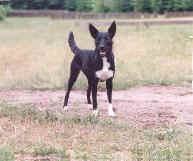 |
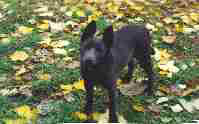 |
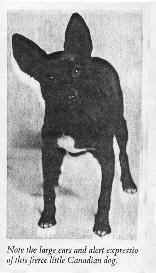 |
You can still see the resemblance in some of the A.I.Dogs today from the old foundation lines I found of their old Tahltan ancestors. Plus through our research it's looking like the northern Tahltans are actually related to the southwestern type Indian dogs of the Apache & Navaho
3600 LAKESHORE DRIVE
SELMA, OREGON 97538
(541) 597-2871
EMAIL